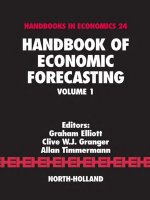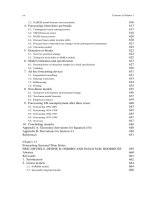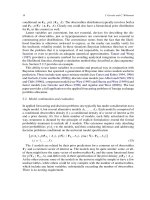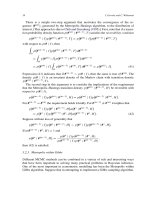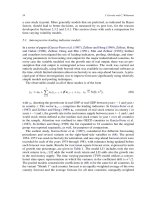Handbook of Economic Forecasting part 86 potx
Bạn đang xem bản rút gọn của tài liệu. Xem và tải ngay bản đầy đủ của tài liệu tại đây (124.02 KB, 10 trang )
824 T.G. Andersen et al.
sample. Without going into specifics, an appropriate procedure may be developed to
obtain a close approximation to this conditional density within a class of SNP densi-
ties which are analytically tractable and allow for explicit computation of the associated
score vector. The leading term will typically consist of a GARCH type model. Essen-
tially, the information regarding the probabilistic structure available from the data is
being encoded into an empirically tractable SNP representation, so that, for a large
enough sample, we have
(4.22)g(r
t
| x
t−1
;ˆη
T
) ≈ f(r
t
|
t−1
;θ
0
),
where g(r
t
| x
t−1
;ˆη
T
) denotes the fitted SNP density evaluated at the (pseudo) max-
imum likelihood estimate ˆη
T
, and θ
0
denotes the true (unknown) parameter vector of
the model generating the data under the null hypothesis. In general, the functional form
of g is entirely different from the unknown f , and hence there is no direct compatibility
between the two parameter vectors η and θ , although we require that the dimension of η
is at least as large as that of θ. Notice how this SNP representation sidesteps the lack
of a tractable expression for the likelihood contribution as given by the middle term in
the likelihood expression in (4.18). Although the SNP density is not used for formal
likelihood estimation, it is used to approximate the “efficient” score moments.
By construction, ˆη
T
satisfies a set of first order conditions for the pseudo log-
likelihood function under the empirical measure induced by the data, that is, letting
r
t
= (r
t
,x
t−1
), it holds that
(4.23)
1
T
T
t=1
∂
∂η
log g(r
t
| x
t−1
;ˆη
T
) ≡
1
T
T
t=1
ψ
T
(r
t
) = 0.
It is clear that (4.23) takes the form of (pseudo) score moments. This representa-
tion of the data through a set of (efficient) moment conditions is the key part of the
“projection step” of EMM. The data structure has effectively been projected onto an
analytically tractable class of SNP densities augmented, as appropriate, by a leading
dynamic (GARCH) term.
Since we are working under the assumption that we have a good approximation to
the underlying true conditional density, we would intuitively expect that, for T large,
(4.24)E
θ
0
ψ
T
(˜r)
≈
1
M
M
i=1
ψ
T
( ˜r
i
) ≈
1
T
T
t=1
ψ
T
(r
t
) = 0,
and any large artificial sample, ˜r
= (˜r
1
, ˜r
2
, ,˜r
N
, ˜x
0
, ˜x
1
, , ˜x
M−1
), generated by
the same assumed (true) data generating process, f(r
t
|
t−1
;θ
0
), that is behind the ob-
served return data, r
. These conjectures are formalized by Gallant and Tauchen (1996),
who show how the pseudo score moments obtained in (4.23) by fixing ˆη
T
can serve as
valid (and efficient) moment conditions for estimating the parameter of interest, θ . Since
no analytic expression for the expectation on the extreme left in (4.24) is available, they
propose a simulation estimator where the expectation is approximated arbitrarily well
Ch. 15: Volatility and Correlation Forecasting 825
by a very large simulated sample moment (M T ) from the true underlying model.
The ability to practically eliminate the simulation error renders the EMM estimator (in
theory) independent of simulation size, M, but the uncertainty associated with the pro-
jection step, for which the sample size is constrained by the actual data, remains and the
estimator,
ˆ
θ
T
, is asymptotically normal with standard errors that reflects the estimation
uncertainty in (4.23).
An obvious attraction of the EMM technique, beyond the potential for efficient infer-
ence, is that there are almost no restrictions on the underlying parametric model apart
from stationarity and the ability to be able to simulate effectively from the model. This
implies that the procedure can be used for continuous-time processes, even if we only
observe a set of discretely sampled data. A seemingly important drawback, however, is
the lack of any implied estimates of the underlying latent state variables which are crit-
ical for successful forecasting. Gallant and Tauchen (1998) provides a solution within
the EMM setting through the so-called reprojection technique, but the procedure can
be used more widely in parametric dynamic latent variable model estimated by other
means as well.
Reprojection takes the parameter estimate of the system as given, i.e., the EMM
estimator for θ in the current context. It is then feasible to generate arbitrarily long sim-
ulated series of observable and latent variables. These simulated series can be used for
estimation of the conditional density via a SNP density function approximation as under
the projection step described above. In other words, the identical procedure is exploited
but now for a long simulated series from the null model rather than for the observed
data sample. For illustration, let ˜r
= (˜r
1
, ˜r
2
, ,˜r
N
, ˜x
0
, ˜x
1
, , ˜x
M−1
) be a long sim-
ulated series from the null model, f(r
i
| F
i−1
;
ˆ
θ
T
), where we condition on the EMM
estimate. We may then utilize the SNP density estimate based on the simulated sample,
g(˜r
t
|˜x
t−1
;˜η), in lieu of the unknown density for practical calculations, where the point
estimate, ˜η, is treated as independent of the sample size M since the estimation error is
negligible for a sufficiently large simulated sample. In effect, the simulations integrate
out the latent variables in the representation (4.5). Given the tractability of the SNP den-
sities, we can now evaluate the one-step-ahead conditional mean and variance (or any
other moments of interest) directly as a function of any observed history x
t−1
by simply
plugging into the SNP density estimate and perform the integration analytically – this is
the reprojection step of recombining the SNP density with the actual data. Clearly, the
corresponding multi-step ahead conditional density estimates can be constructed in an
analogous fashion. Moreover, since the simulations also generate contemporaneous val-
ues for the latent state vectors we may similarly represent the conditional distributions
of future latent state variables given the current and past observable variables through
the SNP density approximation strategy,
(4.25)f
˜s
t+j
˜x
t
;
ˆ
θ
T
≈ g(˜s
t+j
|˜x
t
;˜η), j 0.
This allows for direct forecasts of conditional volatility and associated quantities in a
genuine SV setting. As such, reprojection may be interpreted as a numerically intensive,
826 T.G. Andersen et al.
simulation-based, nonlinear Kalman filtering technique, providing a practical solution
to the filtering and forecasting problems in Equations (4.20) and (4.21).
4.3. Markov Chain Monte Carlo (MCMC) procedures for inference and forecasting
The MCMC method represents a Bayesian approach to the high-dimensional inference
problem implicit in the expression for the likelihood given in Equation (4.18). The ap-
proach was advocated as particularly well suited for analysis of the discrete SV model
by Jacquier, Polson and Rossi (1994). Beyond the standard Bayesian perspective of
treating the model parameters as random variables rather than fixed coefficients, the
main conceptual shift is that the entire latent state vector is treated as additional parame-
ters. Hence, the main focus is on the joint distribution of the parameters and the vector
of state variables, ψ = (θ, s
), conditional on the data, f(ψ | r ), termed the posterior
distribution. This density is extremely high dimensional and analytically intractable.
The MCMC approach instead exploits that the joint distribution can be characterized
fully through a set of associated conditional distributions where the density for a group
of parameters, or even a single parameter, is expressed conditional on the remaining
parameters. Concretely, let ψ
i
denote the ith group of coefficients in ψ, and ψ
−I
be
the vector obtained from ψ by excluding the ith group of coefficients. The so-called
Clifford–Hammersley theorem then implies that the following set of conditional distri-
butions determines f(ψ | r
):
(4.26)f(ψ
1
| ψ
−1
,r), f (ψ
2
| ψ
−2
,r), . . . , f (ψ
k
| ψ
−k
,r),
where, as described above, ψ = (ψ
1
,ψ
2
, ,ψ
k
) is treated as k exclusive subsets of
parameters.
The MCMC procedure starts by initializing ψ = (θ, s
) through conditioning on the
observed data, r
, and drawing ψ from the assumed prior distribution. Next, by combin-
ing the current draw for the parameter vector with the specified SV model dynamics and
the observed returns, it is often feasible to draw the (group of) parameters sequentially
conditional on the remainder of the system and cycle through the conditional densities
in (4.26). A full run through the parameter vector is termed a sweep of the MCMC sam-
pler. Some of these distributions may not be given in closed form and the draws may
need to be extended through an accept–reject procedure termed a Metropolis–Hastings
algorithm to ensure that the resulting Markov chain produces draws from the invari-
ant joint posterior target distribution. If all the conditional distributions can be sampled
directly we have a Gibbs sampler, but SV models often call for the two techniques to
be used at different stages of the sweep, resulting in a hybrid MCMC algorithm. Typi-
cally, a large number of sweeps is necessary to overcome the serial dependence inherent
in draws of any parameter from subsequent sweeps of the sampler. Once a long sample
from the joint posterior distribution has been generated, inference on individual parame-
ters and latent state variables can be done via the mode, mean and standard deviation of
the posterior distribution, for example. Likewise, we can analyze properties of functions
of the state variables directly using the posterior distribution.
Ch. 15: Volatility and Correlation Forecasting 827
A key advantage of the MCMC procedure is that the distribution of the latent state
vector is obtained as an inherent part of the estimation. Moreover, the inference au-
tomatically accounts for the uncertainty regarding model parameters, θ. The resulting
chain produces an elegant solution to the smoothing problem of determining f(s
| r).
Of course, from a forecasting perspective, the interest is in determining f(s
t+j
| x
t
),
where the integer j 0 and x
t
= (r
1
,r
2
, ,r
t
), rather than f(s
t+j
| x
T
) which
is generated by the MCMC procedure. Unfortunately, the filter related distribution,
f(s
t+1
| x
t
), corresponds to the intractable term in Equation (4.18) that renders the
likelihood estimation impractical for genuine SV models. The MCMC inference pro-
cedure succeeds by sidestepping the need to compute this quantity. However, given the
economic import of the issue, recent research is actively seeking new effective ways for
better handling the filtering problem within the MCMC framework.
For a discrete-time SV model, the possibility of filtering as well as sequential one-
step-ahead volatility forecasting is linked to the feasibility of providing an effective
scheme to generate a random sample from f(s
t+1
| x
t
,θ) given an existing set of
draws (or particles), s
1
t
,s
2
t
, ,s
N
t
, from the preceding distribution f(s
t
| x
t−1
,θ).
Such an algorithm is termed a particle filter. In order to recognize the significance of
the particle filter, note that by Bayes’ law,
(4.27)f(s
t+1
| x
t+1
,θ)∝ f(r
t+1
| s
t+1
, θ)f (s
t+1
| x
t
,θ).
The first distribution on the right-hand side is typically specified directly by the SV
model, so the issue of determining the filtering distribution on the left-hand side is
essentially equivalent to the task of obtaining the predictive distribution of the state
variable on the extreme right. But given a large set of particles we can approximate the
latter term in straightforward fashion,
f(s
t+1
| x
t
,θ)=
f(s
t+1
| s
t
, θ)f (s
t
| x
t
,θ)ds
t
(4.28)≈
1
M
M
j=1
f
s
t+1
s
j
t
,θ
.
This provides a direct solution to the latent state vector forecasting problem, that in turn
can be plugged into (4.27) to provide a sequential update to the particle filter. This in
essence is the MCMC answer to the filtering and out-of-sample forecasting problems
in Equations (4.20) and (4.21). The main substantive problem is how to best sample
from the last distribution in (4.28), as schemes which may appear natural can be very
inefficient; see, e.g., the discussion and suggestions in Kim, Shephard and Chib (1998).
In summary, the MCMC approach works well for many problems of significant in-
terest, but there are serious issues under scrutiny concerning the use of the technique
for more complex settings. When applicable, it has some unique advantages such as
providing a complete solution to the smoothing problem and accounting for inherent
parameter estimation uncertainty. On the other hand, there are systems that are more
828 T.G. Andersen et al.
amenable to analysis under EMM and the associated diagnostic tools and general repro-
jection procedures under EMM render it a formidable contender. It is remarkable that
the issues of efficient forecasting and filtering within genuine SV models now has two
attractive, albeit computationally intensive, solutions whereas just a few years ago no
serious approach to the problem existed.
4.4. Further reading
The formal distinction between genuine stochastic volatility and ARCH models is de-
veloped in Andersen (1992); see also Fleming and Kirby (2003). An early advocate for
the Mixture-of-Distributions-Hypothesis (MDH), beyond Clark (1973),isPraetz (1972)
who shows that an i.i.d. mixture of a Gaussian term and an inverted Gamma distribu-
tion for the variance will produce Student t distributed returns. However, if the variance
mixture is not linked to observed variables, the i.i.d. mixture is indistinguishable from
a standard fat-tailed error distribution and the associated volatility process is not part of
the genuinely stochastic volatility class.
Many alternative representations of the driving process s
t
have been proposed. Clark
(1973) observes that trading volume is highly correlated with return volatility and sug-
gest that volume may serve as a good proxy for the “activity variable”, s
t
. Moreover, he
finds volume to be approximately lognormal(unconditionally), suggesting a lognormal–
normal mixture for the return distribution. One drawback of this formulation isthatdaily
trading volume is assumed i.i.d. Not only is this counterfactual for trading volume, but
it also implies that the return process is i.i.d. This is at odds with the strong empirical
evidence of pronounced temporal dependence in return volatility. A number of nat-
ural extensions arise from the simple MDH. Tauchen and Pitts (1983) provide a more
structural interpretation, as they develop a characterization of the joint distribution of
the daily return and volume relationship governed by the underlying latent information
flow s
t
. However, partially for tractability, they retain the temporal independence of the
information flow series. For early tests of the MDH model using high-frequency data
[see, e.g., Harris (1986, 1987)], while the early return-volume literature is surveyed by
Karpoff (1987). Gallant, Rossi and Tauchen (1992) provides an extensive study of the
joint conditional distribution without imposing any MDH restrictions. Direct studies of
the MDH include Lamoureux and Lastrapes (1994) and Richardson and Smith (1994).
While the latter strongly rejects the standard MDH formulation, Andersen (1996) devel-
ops an alternative structurally based version of the hypothesis and finds the “modified”
MDH to perform much better. Further refinements in the specification have been pur-
sued by, e.g., Liesenfeld (1998, 2001) and Bollerslev and Jubinsky (1999). In principle,
the use of additional nonreturn variables along with return data should enhance estima-
tion efficiency and allow for a better assessment of current market conditions. On the
other hand, it is far from obvious that structural modeling of complicated multivariate
models will prove useful in a prediction context as even minor misspecification of the
additional series in the system may impede forecast performance. In fact, there is no
credible evidence yet that these models help improve volatility forecast performance,
Ch. 15: Volatility and Correlation Forecasting 829
even if they have importantly enhanced our understanding of the qualitative functioning
of financial markets.
SV diffusion models of the form analyzed by Hull and White (1987) were also pro-
posed concurrently by Johnson and Shanno (1987), Scott (1987), and Wiggins (1987).
An early specification and exploration of a pure jump continuous-time model is Merton
(1976). Melino and Turnbull (1990) were among the first to estimate SV models via
GMM. The log-SV model from (4.2)–(4.3) has emerged as a virtual testing ground for
alternative inference procedures in this context. Andersen and Sørensen (1996) provide
a systematic study of the choice of moments and weighting matrix for this particular
model. The lack of efficiency is highlighted in Andersen, Chung and Sørensen (1999)
where the identical model is estimated through the scores of an auxiliary model devel-
oped in accordance with the efficient method of moments (EMM) procedure. Another
useful approach is to apply GMM to moment conditions in the spectral domain; see,
e.g., Singleton (2001), Jiang and Knight (2002), and Chacko and Viceira (2003). Within
the QMLE Kalman filter based approach, a leverage effect may be incorporated and al-
lowance for the idiosyncratic return error to be conditionally Student t distributed can be
made, as demonstrated by Harvey, Ruiz and Shephard (1994) and Harvey and Shephard
(1996). Andersen and Sørensen (1997) provides an extensive discussion of the relative
efficiency of QMLE and GMM for estimation of the discrete-time log-SV model. The
issue of asymptotically optimal moment selection for GMM estimation from among
absolute or log squared returns in the log-SV model has received a near definitive treat-
ment in Dhaene and Vergote (2004). The standard log-SV modelhasalso been estimated
through a number of other techniques by among others Danielsson and Richard (1993),
Danielsson (1994), Fridman and Harris (1998), Monfardini (1998), and Sandmann and
Koopman (1998). Long memory in volatility as discussed in Section 3.4 can be simi-
larly accommodated within an SV setting; see, e.g., Breidt, Crato and de Lima (1998),
Harvey (1998), Comte and Renault (1998), and Deo and Hurvich (2001). Duffie, Pan
and Singleton (2000) is a good reference for a general treatment of modeling with the
so-called affine class of models, while Piazzesi (2005) provides a recent survey of these
models with a view toward term structure applications.
EMM may be seen as a refinement of the Method of Simulated Moments (MSM)
of Duffie and Singleton (1993), representing a particular choice of indirect inference
criterion, or binding function, in the terminology of Gouriéroux, Monfort and Renault
(1993). The approach also has precedents in Smith (1990, 1993). An early application of
EMM techniques to the discrete-time SV model is Gallant, Hsieh and Tauchen (1997).
Among the earliest papers using EMM for stochastic volatility models are Andersen and
Lund (1997) and Gallant and Tauchen (1997). Extensions of the EMM approach to SV
jump-diffusions are found in Andersen, Benzoni and Lund (2002)
and Chernov et al.
(2003). As a starting point for implementations of the EMM procedure, one may access
general purpose EMM and SNP code from a web site maintained by A. Ronald Gallant
and George E. Tauchen at Duke University at the link ftp.econ.duke.edu in the direc-
tories /pub/get/emm and /pub/arg/snp, respectively. In practical applications, it is of-
ten advantageous to further refine the SNP density approximations through specifically
830 T.G. Andersen et al.
designed leading GARCH terms which parsimoneously capture the dependency struc-
ture in the specific data under investigation. The benefits of doing so is further discussed
in Andersen and Lund (1997) and Andersen, Benzoni and Lund (2002).
The particle filter discussed above for the generation of filter estimates for the latent
variables of interest within the standard SV model arguably provides a more versa-
tile approach than the alternative importance sampling methods described by, e.g.,
Danielsson (1994) and Sandmann and Koopman (1998). The extension of the MCMC
inference technique to a continuous-time setting is discussed in Elerian, Chib and Shep-
hard (2001) and Eraker (2001). The latter also provides one of the first examples of
MCMC estimation of an SV diffusion model, while Eraker, Johannes and Polson (2003)
further introduces jumps in both prices and volatility. Johannes and Polson (2005) offer
a recent comprehensive survey of the still ongoing research on the use of the MCMC
approach in the general nonlinear jump-diffusion SV setting.
5. Realized volatility
The notion of realized volatility has at least two key distinct implications for practical
volatility estimation and forecasting. The first relates to the measurement of realizations
of the latent volatility process without the need to rely on an explicit model. As such, the
realized volatility provides the natural benchmark for forecast evaluation purposes. The
second relates to the possibility of modeling volatility directly through standard time se-
ries techniques with discretely sampled daily observations, while effectively exploiting
the information in intraday high-frequency data.
5.1. The notion of realized volatility
The most fundamental feature of realized volatility is that it provides a consistent non-
parametric estimate of the price variability that has transpired over a given discrete
interval. Any log-price process subject to a no-arbitrage condition and weak auxiliary
assumptions will constitute a semi-martingale that may be decomposed into a locally
predictable mean component and a martingale with finite second moments. Within
this class, there is a unique measure for the realized sample-path variation termed the
quadratic variation. By construction the quadratic variation cumulates the intensity of
the unexpected price changes over the specific horizon and it is thus a prime candidate
for a formal volatility measure.
The intuition behind the use of realized volatility as a return variation measure is most
readily conveyed within the popular continuous-time diffusion setting (4.9) obtained
by ruling out jumps and thus reducing to the representation (1.7), reproduced here for
convenience,
(5.1)dp(t) = μ(t) dt + σ(t)dW(t), t ∈[0,T].
Ch. 15: Volatility and Correlation Forecasting 831
Applying a discretization of the process as in Section 1,wehaveforsmall>0, that
(5.2)r(t,) ≡ p(t) − p(t −) μ(t − ) + σ(t − ) W(t),
where W (t) ≡ W(t)− W(t − ) ∼ N(0,).
Over short intervals the squared return and the squared return innovation are closely
related as both are largely determined by the idiosyncratic return component,
r
2
(t, ) μ
2
(t − )
2
+ 2μ(t − )σ (t − ) W(t)
(5.3)+ σ
2
(t − )
W (t)
2
.
In particular, the return variance is (approximately) equal to the expected squared return
innovation,
(5.4)Var
r(t,)
F
t−
E
r
2
(t, )
F
t−
σ
2
(t − ).
This suggests that we may be able to measure the return volatility directly from the
squared return observations. However, this feature is not of much direct use as the
high-frequency returns have a large idiosyncratic component that induces a sizeable
measurement error into the actual squared return relative to the underlying variance. Up
to the dominant order in ,
(5.5)Var
r
2
(t, )
F
t−
2σ
4
(t − )
2
,
where terms involving higher powers of are ignored as they become negligible for
small values of . Thus, it follows that the “noise-to-signal” ratio in squared returns
relative to the underlying volatility is of the same order as volatility itself,
(5.6)
Var[r
2
(t, ) | F
t−
]
E[r
2
(t, ) | F
t−
]
2E
r
2
(t, )
F
t−
.
This relationship cannot be circumvented when only one (squared) return observation
is used as a volatility proxy. Instead, by exploiting the fact that return innovations, un-
der a no-arbitrage (semi-martingale) assumption, are serially uncorrelated to construct
volatility measures for lower frequency returns we find, to dominant order in ,
1/
j=1
E
r
2
(t − 1 +j ·, )
F
t−1+j·
1/
j=1
σ
2
(t − 1 +j ·) ·
(5.7)
t
t−1
σ
2
(s) ds,
where the last approximation stems from the sum converging to the corresponding
integral as the size of shrinks toward zero. Equation (5.7) generalizes (5.4) to the
multi-period setting with the second approximation in (5.7) only being meaningful for
small.
The advantage of (5.7) is that the uncorrelated “measurement errors” have been ef-
fectively smoothed away to generate a much better noise-to-signal ratio. The expression
832 T.G. Andersen et al.
in (5.5) may be extended in a similar manner to yield
1/
j=1
Var
r
2
(t − 1 +j ·, )
F
t−1+j·
2
1/
j=1
σ
4
(t − 1 +j ·) ·
2
(5.8) 2
t
t−1
σ
4
(s) ds.
Consequently,
1/
j=1
Var[r
2
(t − 1 +j ·, ) | F
t−1+j·
]
1/
j=1
E[r
2
(t − 1 +j ·, ) | F
t−1+j·
]
2
t
t−1
σ
4
(s) ds
t
t−1
σ
2
(s) ds
(5.9)≡ 2
IQ(t)
IV(t)
,
where the integrated quarticity is defined through the identity on the right-hand side
of (5.9), with the integrated variance, IV(t), having previously been defined in (4.12).
The fact that the “noise-to-signal” ratio in (5.9) shrinks to zero with suggests that
high-frequency returns may be very useful for estimation of the underlying (integrated)
volatility process. The notion of realized volatility is designed to take advantage of these
features. Formally, realized volatility is defined as
(5.10)RV(t, ) =
1/
j=1
r
2
(t − 1 +j ·, ).
Equation (5.8) suggests that realized volatility is consistent for the integrated volatility
in the sense that finer and finer sampling of the intraday returns, → 0, ultimately will
annihilate the measurement error and, in the limit, realized volatility measures the latent
integrated volatility perfectly, that is,
(5.11)RV(t, ) → IV(t),
as → 0. These arguments may indeed by formalized; see, e.g., the extended dis-
cussion in Andersen, Bollerslev and Diebold (2005). In reality, there is a definite lower
bound on the return horizon that can be used productively for computation of the re-
alized volatility, both because we only observe discretely sampled returns and, more
important, market microstructure features such as discreteness of the price grid and bid–
ask spreads induce gross violations of the semi-martingale property at the very highest
return frequencies. This implies that we typically will be sampling returns at an intraday
frequency that leaves a nonnegligible error term in the estimate of integrated volatility.
It is natural to conjecture from (5.9) that asymptotically, as → 0,
(5.12)
1/
RV(t, ) − IV(t)
∼ N
0, 2 · IQ(t)
,
which turns out to be true under quite general assumptions. Of course, the IQ(t) measure
must be estimated as well for the above result to provide a practical tool for inference.
Ch. 15: Volatility and Correlation Forecasting 833
The distributional result in (5.12) and a feasible consistent estimator for IQ(t) based
purely on intraday data have been provided by Barndorff-Nielsen and Shephard (2002,
2004b). It may further be shown that these measurement errors are approximately un-
correlated across consecutive periods which has important simplifying implications for
time series modeling.
The consistency result in (5.11) extends to the general semi-martingale setting where
the price path may display discontinuities due to jumps, as specified in Equation (4.9).
The realized volatility will still converge in the continuous-record limit ( → 0) to
the period-by-period quadratic variation of the semi-martingale. However, the quadratic
variation is no longer identical to the integrated volatility but will also include the cu-
mulative squared jumps,
(5.13)RV(t, ) → QV(t) =
t
t−1
σ
2
(s) ds +
t−1<st
κ
2
(s).
A few comments are in order. First, QV(t) is best interpreted as the actual return vari-
ation that transpired over the period, and as such it is the natural target for realized
volatility measurement. Second, QV(t) is the realization of a random variable which
generally cannot be forecasted with certainty at time t − 1. But it does represent the fu-
ture realization that volatility forecasts for time t should be compared against. In other
words, the quadratic variation constitutes the quantity of interest in volatility measure-
ment and forecasting. Since the realizations of QV(t) are latent, it is natural to use the
observed RV(t, ) as a feasible proxy. Third, financial decision making is concerned
with forecasts of volatility (or quadratic variation) rather than the QV(t ) directly. Fourth,
the identification of forecasts of return volatility with forecasts of quadratic variation
is only approximate as it ignores variation in the process induced by innovations in
the conditional mean process. Over short horizons the distinction is negligible, but for
longer run volatility prediction (quarterly or annual) one may need to pay some atten-
tion to the discrepancy between the two quantities, as discussed at length in Andersen,
Bollerslev and Diebold (2005).
The distribution theory for quadratic variation under the continuous sample path as-
sumption has also been extended to cover cumulative absolute returns raised to an arbi-
trary power. The leading case involves cumulating the high-frequency absolute returns.
These quantities display improved robustness properties relative to realized volatility as
the impact of outliers are mitigated. Although the limiting quantity – the power vari-
ation – is not directly linked to the usual volatility measure of interest in finance, this
concept has inspired further theoretical developments that has led to intriguing new non-
parametric tests for the presence of jumps and the identification of the associated jump
sizes; see, e.g., Barndorff-Nielsen and Shephard (2004a). Since the jumps may have
very different intertemporal persistence characteristics than the diffusion volatility, ex-
plicit disentangling of the components of quadratic variation corresponding to jumps
versus diffusion volatility can have important implications for volatility forecasting.
In summary, the notion of realized volatility represents a model-free approach to
(continuous-record) consistent estimation of the quadratic return variation under general

